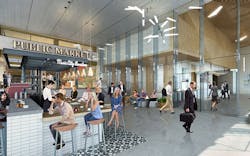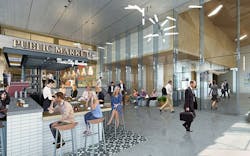The retail renaissance part II: The role of planning and development in the future of shopping
In the first post of our Retail Renaissance blog series, my colleague Vanessa Newton provided an architectural perspective on several common trends in the retail world: a decrease in brick-and-mortar stores and a big jump in online sales, the growth of mixed-use developments, and most importantly, a focus on customer experience. In fact, I think many of us at GS&P would argue that customer experience is the common thread throughout most recent trends, which is why experience-focused design and development is a priority at our firm.
As a senior land planner, I’m here to provide another perspective on the trends unfolding in the retail world. They impact architecture and interior design in a pretty direct way, but the planning and development implications are more nuanced. Planners have to think of the ways that vertical retail structures interact with the surrounding site and community. Here are a few things I expect we’ll see more of in the future:
Smaller retail floorplates
As online retail continues to grow, duplication of product in stores becomes less important. “Showrooming,” which is the practice of perusing merchandise in a brick-and-mortar store then purchasing online, often at a lower price, is increasingly common. As a result, clothing stores don’t need to carry as many different sizes, colors and other options as they used to, and appliances retailers like Best Buy and Lowe’s may carry only display models in store, while offering free or discounted home delivery directly from a warehouse. Fewer products then equals a smaller floorplate and less real estate. And less real estate can mean cost savings in some cases, or it may just allow certain retailers the financial ability to locate in a more expensive, denser urban area.
The evolution of the checkout process at grocery stores and other retailers may also impact the floorplate. Kroger and Walmart already offer curbside grocery pickup and checkout services, meaning fewer people using the in-store checkout aisles. And companies like Amazon are experimenting with cell phone-powered technology that charge customers for their goods as they exit the store – no checkout required. Fewer checkout lanes also mean less real estate.
Smaller parking lots
Another trend toward less real estate is fueled by smaller parking lots. Particularly in urban settings, motorists are gradually being replaced by cyclists, public transit riders and pedestrians. The impact of ride-sharing services like Uber and Lyft on parking needs are also undeniable. Planners are increasingly designing exterior space for Uber pick-up and drop-off, as more and more people choose to leave their vehicles at home (or not own them at all). Further out on the horizon, autonomous vehicles will be a big influence on parking needs (which was discussed in more depth on GS&P Dialogue a few months ago). Self-driving cars can simply return home after taking their owner to work or dinner or be dispatched for use by other riders, so on-site parking spaces could one day be nearly obsolete.
More outdoor space
The trend toward mixed-use developments, which typically include a variety of spaces – retail, entertainment, office and residential – all in one location, means an increase in outdoor space. Most mixed-use facilities include trees and greenery, park benches and al fresco restaurant seating. The shopping mall of yesterday with its endless indoor corridors and fluorescent lights has been replaced by shopping and dining beneath clear, blue skies. “Paving paradise to put up a parking lot” may have come full circle, as planners start to incorporate green space in place of parking spots.
It all comes back to customer experience
At the core of all these planning and development trends is an emphasis on customer experience. Browsing in-store and buying online is often the best (and most affordable) approach to retail, as is automatic checkout. Getting dropped off at the front door of your favorite store is a lot less hassle than circling a parking lot looking for an empty space. And shopping on the first-floor of the building where you work or live is more pleasant than traveling to a different part of town. Retail, now more than ever, is driven by an emphasis on convenience, cost and experience. Success requires an eagerness to go where the shoppers want to take us.
About the Author
Gresham Smith
The Gresham Smith blog is about starting discussions. We want to get people thinking about issues and trends that are impacting the design services industry and the market sectors Gresham Smith architects, engineers, interior designers, planners, consultants and environmental scientists serve. Great ideas are typically enhanced through conversation and often stifled by singular views and opinion. We hope you'll join in this conversation and help us to create a meaningful dialogue. Follow us on Facebook, Instagram, LinkedIn, Twitter, Vimeo, and YouTube.



